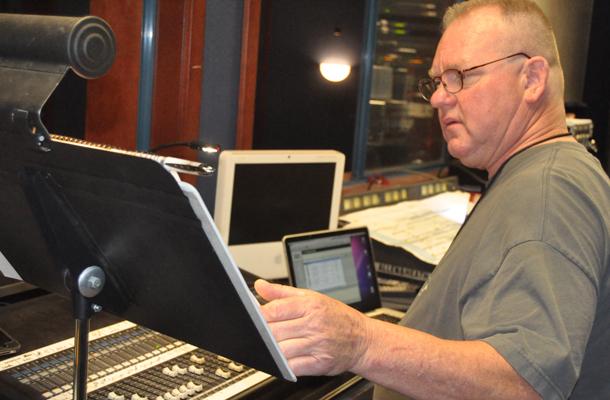Amidst the shadowy chaos just off stage, Les Miserables stage manager Sam Heckle feverishly tied a cast member’s apron during a recent Saturday night’s performance.
“Sam, is my mike pack tucked in?” the performer asked.
Heckle nodded, and with that, the cast member rushed from the wing and onto the stage.
Beyond the darkened wings, in the green room of the performing arts center, 3 theater tech students worked furiously, taking microphone packs off the ensemble members who had just exited the stage and transferring them to other cast members going on stage.
“Are you little Cosette?” junior Ethan Tonomura hurriedly asked a young brunette girl.
“Yes,” the girl affirmed.
“Can you help her put on the belt?” Tonomura inquired of sophomore Jennifer Gregory.
Gregory, who was busy helping a different cast member, did not respond. On stage singing flittered through overhead speakers.
“Jennifer!”
Gregory finished with the other cast member and moved on to little Cosette, while Tonomura placed a microphone piece around cast member Kelly Williams’ ear.
“OK, you can go on,” Gregory instructed, then quickly moved on to help Tonomura. Gregory expertly threaded the microphone cable through Williams’ blouse while Tonomura taped the mouthpiece onto Williams’ face. The second they were done, Williams ran off.
Gregory sighed, smiled, and said, “This is how it is, every day.”
Throughout the production of Campolindo’s spring musical, Les Miserables, students in the Theater Tech club, parent volunteers, and other community members worked with stage director Dave Pinkham behind the black curtains to keep the microphones, lights, sets, stage, and costumes of the show functioning flawlessly.
As it was a musical, sound was a paramount concern.
“Microphones are crazy in all of the shows we do. In this show, they’re really crazy. Because this is an ensemble show, there are clearly main characters. But because it’s almost an opera, and it’s sung through, every line in the show has to be amplified,” said Pinkham.
“And because we don’t have a pit, thank you very much to whoever designed this theater and couldn’t figure out how to put a pit in here for the orchestra, it’s too loud, which means we always have to have amplification.”
According to Pinkham, 52 cast members sing in Les Miserables and must share 16 microphones among them over the course of the show. Accuracy is crucial. Give the wrong microphone to the wrong person, and “in the scene that that person is singing in, we’re going to hear somebody from the green room,” said Pinkham.
The microphones transmit sound from the actors’ microphone packs to a soundboard in the control booth at the back of the theater. Sound designer Ross Wilson manages the board during the performance.
Tonomura, a 3rd year theater tech veteran, is responsible for checking microphones before the show, placing microphones on actors, and facilitating microphone swaps during the show.
“Overall, it’s a little hectic and stressful at times, because everyone’s running around making sure they have the right costumes, they know when they’re supposed to go on, they have the right mike, the mike’s still working,” Tonomura said. “And I guess it’s a little stressful, but it’s still fun and you can still find enjoyment in it even while everyone is running around.”
While sound is at the core of the show, it wouldn’t be much more than a radio performance if the audience could not see the action. High above the stage and audience, 4 theater tech students on the catwalk operated spotlights. When given the cue by Pinkham, they followed an actor with their hand operated lights.
The lighting, including mechanically operated and computer orchestrated elements, was designed by Campolindo graduate and former musical stage manager Lyle Barrere. “Lyle had an aptitude for that kind of stuff and he really dove into it deeply, and understood the ins and outs of all of the technical side of theater,” Pinkham said. “He’s always been faithful. He always comes back and does the lights for us. So all the moving lights for the show, those are all his.”
But certain key lighting is still manage by hand.
Senior Brendan Wilson, who said he “just signed up for it, for Les Mis, because I had nothing better to do,” is one of the appropriately-named “follow-spots.”
“I showed up. I was confronted with a person who had been doing it. I was told, ‘Put on a headset.’ If they tell you follow spot 4, you follow that person and move around with them until your light goes out,” Wilson said.
“It’s cool. You get to see everything from above, you get to see the play like 8 times for free all from above and get a piece of the production, ‘cause you go backstage and you see people move around, and it’s really cool seeing how it comes together,” Wilson said.
The professionally-inspired sets were designed by Pinkham and senior Marissa Monopoli between September and December.
The Campolindo musical theater program had put on a Les Miserables previously in 2004. At that time, Pinkham and then choir director Gene Peterson saw two of a professional touring company’s productions of Les Miserables in Boston. Pinkham “took a lot notes.”
He and Peterson wanted their show to closely resemble a professional production’s. “People hadn’t seen Les Mis as much as they have now. There was no movie, it was not available for amateur production. And so there were two touring companies, and it had been through San Francisco a couple times, so people knew the show, but it wasn’t like everybody had seen it, everybody had heard the music,” said Pinkham. “But then, I felt like the people who have seen the show are going to have an expectation for what we’re going to do. They’re going to expect that it’s sort of the standard high school musical, and that we’re going to hack it up.”
According to Pinkham, this year’s set design was “fairly straightforward.” He said, “I had a preconceived notion of what we were going to do, or what worked for us before. And rather than reinvent the wheel, since enough time had gone by, I felt like it wasn’t really necessary to completely revamp everything. So I used a lot of similar things to what we did 11 years ago.”
“I incorporated some things that I had done in another production of Les Mis that I did after the 2004 one, not here, and then just worked with Marissa, who expressed an early desire to be involved with set design, to kind of fill in the blanks. I sort of did the requirements part of the design – we’ve gotta have a building here, we’ve gotta have a building there, we’re going to do a rotating turntable, we’re going to have a catwalk in the back and some kind of a backdrop – and then she kind of filled in the blanks,” Pinkham said. “I’m horrible with colors and she’s great with colors, so she worked on the color part of it, and organized some students to help us with the scenic painting.”
By winter break, Pinkham and Monopoli had a model in hand, and were ready for the parents to start building the sets.
“I’m fortunate that in this area, parents are pretty willing to put time in,” said Pinkham. “So we have a group of about, I’d say, 10 or 12 parents, of whom maybe 4 or 5 show up every single week. And we’re up there [at the warehouse near the football field] from 9 in the morning on Saturday until maybe 2 in the afternoon, sometimes later, every week from winter break all until we open.”
During some shows, assistant stage manager Mike Wilson, the father of senior cast member Alex Wilson, is part of a team responsible for getting the sets on and off the stage in between scenes. “It’s nerve wracking. Each side has a crew, and on each side one person is wearing a headset. They listen to Dave say, ‘Okay, go, move the set.’ He calls it a shift,” Mike Wilson explained.
The sets had to be moved with precision, to various positions marked on the rotating stage, and locked into place to prevent the sets from shifting or falling when the turntable rotated. “It’s pretty chaotic, but they know what they’re doing now,” said Mike. Wilson. “Occasionally you hear a crash or something like that, but that’s what happens when you’re rolling a barricade in a revolution.”
He added, “It’s nervewracking and exciting and fun and a completely different way to experience musical theater here.”
Heckle said, “It’s a little bit stressful because we’re trying to get all of the sets on in like 10 seconds and then leave the stage. Other than that though, once the stuff is on, taking it off is easy. It’s alright, it’s not that hard.”
The centerpiece of the Les Mis set is a giant rotating disk called a turntable. Like much of the stage design, the turntable was inspired by the Broadway production and was also used in the 2004 production at Campolindo.
“The underlying theme of Les Mis is turning. Even though people don’t really think of it, that was a really important theme to the authors of the show,” Pinkham said.
“Several times in the lyrics, two different characters refer to the turning of the years. And then there’s a whole number, right after the big battle scene, that doesn’t have a name really, but we call it ‘Turning’ because a whole bunch of women come out and sing about the turning of the years. And it’s just [sung] ‘Turning, turning, turning of the years.’ And so that’s kind of where the turntable idea originated,” Pinkham explained.
The turntable was obtained from the now defunct Willows Theater in Concord. “Back then, when we first did the show, one of the students here was the daughter of [former] artistic director of the Willows Theater. And so he just offered to lend it to us, which was really nice,” said Pinkham. “Since then the Willows Theater has closed, but I sort of kept track of where all of their stuff went. I was able to find the guy who had this turntable and I was able to get him to give [rent] it to us.”
Installing the turntable was difficult. The turntable is raised about 6 inches off the ground, so Pinkham and the set crew had to add an extra raised platform to the entire stage to raise the whole stage to the turntable’s level.
Because other programs use the CPAC during the school day, the stage construction and turntable installation could not begin until the weekend before tech rehearsals. “We had a Saturday and a Sunday to put everything in. So we started this on scratch on Saturday, and that [turntable] came in on Friday night, and we had that set up on Friday night, and basically two of the guys on my set crew built that [raised stage] on Saturday. And then Sunday we got more or less all the rest of the stuff up,” Pinkham said.
Mike Wilson alternated with fellow parent Dave Evans in operating the turntable from a small hole underneath the stage catwalk.
“We picked up the name ‘the trolls’ because we sit under the bridge. And it’s really neat because that again, it’s a completely different perspective on the musical,” Mike Wilson said. “It is a different perspective than anybody gets to see on a live musical show because you’re literally onstage.”
He added, “To have set pieces moved from the back of the stage to the front of the stage, or from upstage to downstage, it really adds another dimension for the audience. It makes the sets that much deeper and more interesting.”
In addition to the elaborate set design, the authentic style of the performance was also supported by detailed costumes.
“With this particular show, it’s very critical that the fashions were of the time,” said costume designer Kim Purcell.
Purcell, who is the mother of sophomore cast member Jocelyn Purcell, first discussed Pinkham’s vision with him. Pinkham wrote out a “costume plot” identifying the general idea and requirements for each costume that each character wears in each scene. Then, Purcell looked up the time period’s fashion styles and costumes from other Les Miserables productions through Google Images.
A few “basic pieces” such as peasant clothing, could be reused from prior productions, but most of the costumes from Campolindo’s previous Les Miserables couldn’t be reused. Purcell said, “Because they had done the show, 10, 11 years ago there was not much still available from what they used then.”
Some clothing pieces, like jackets for Thenardier and Javert, were found on Ebay. Marius’ revolution coat was bought at a specialty store. Many specialty pieces, such as Madame Thenardier’s dress for Cosette and Marius’ wedding, ballgowns, and time-period specific tailcoats, were rented from the ACT Theater in San Francisco. Still more were sewed by a crew of mothers who either embellished or made from scratch Cosette’s black dress, little Cosette’s blue dress, 27 factory worker’s hats, and skirts for the prostitutes.
“I had a really fantastic group of ladies who pumped out some of the products that we couldn’t buy or had a specific vision that I wanted to get done,” Purcell said.
Parent volunteers were also instrumental in providing support during the actual performances. “[I] had moms helping me in the dressing rooms every night, repairing things, because a lot of the things from ACT needed a lot of work, moms helping to get them [cast members] in and out of their costumes for some of the quick costume changes,” Purcell said.
The entire production, from the sound and lighting elements to the set and costume elements, to the action and singing of the actors, all came together under the direction of Pinkham each night.
Pinkham talks to stage managers, the turntable operator, follow spot operator, sound engineer during each show via a headset. “So he’s coordinating an awful lot of activity,” Mike Wilson added.
Heckle said she is “in charge of moving all of the sets and making sure that everything is running smoothly behind the stage.”
Mike Wilson said that both were instrumental to the production. “You can tell it’s a labor of love with what he [Pinkham] does. He is far humbler than he lets on,” M. Wilson said. “He does an amazing job, and the school wouldn’t have the program, anything close to what they have, without him. The community who really supports this program really owes him a debt because who else would step up?”
Mike Wilson said Pinkham once spent one night in the CPAC past midnight bolting things onto the barricade.
“Sam Heckle has risen to the occasion in being the real quarterback of what happens backstage. I think unusual for a kid of her age – and yes, she’s a senior – to take command and give orders to adults and to make things happen, and by the force of her will get things done. And she’s done an extraordinary job making this happen,” Mike Wilson added.
Of support she and the other on-stage performers received from this army parents and students, junior Michelle Anjani, who played Montparnasse, said, “The show relies so much on them.”



